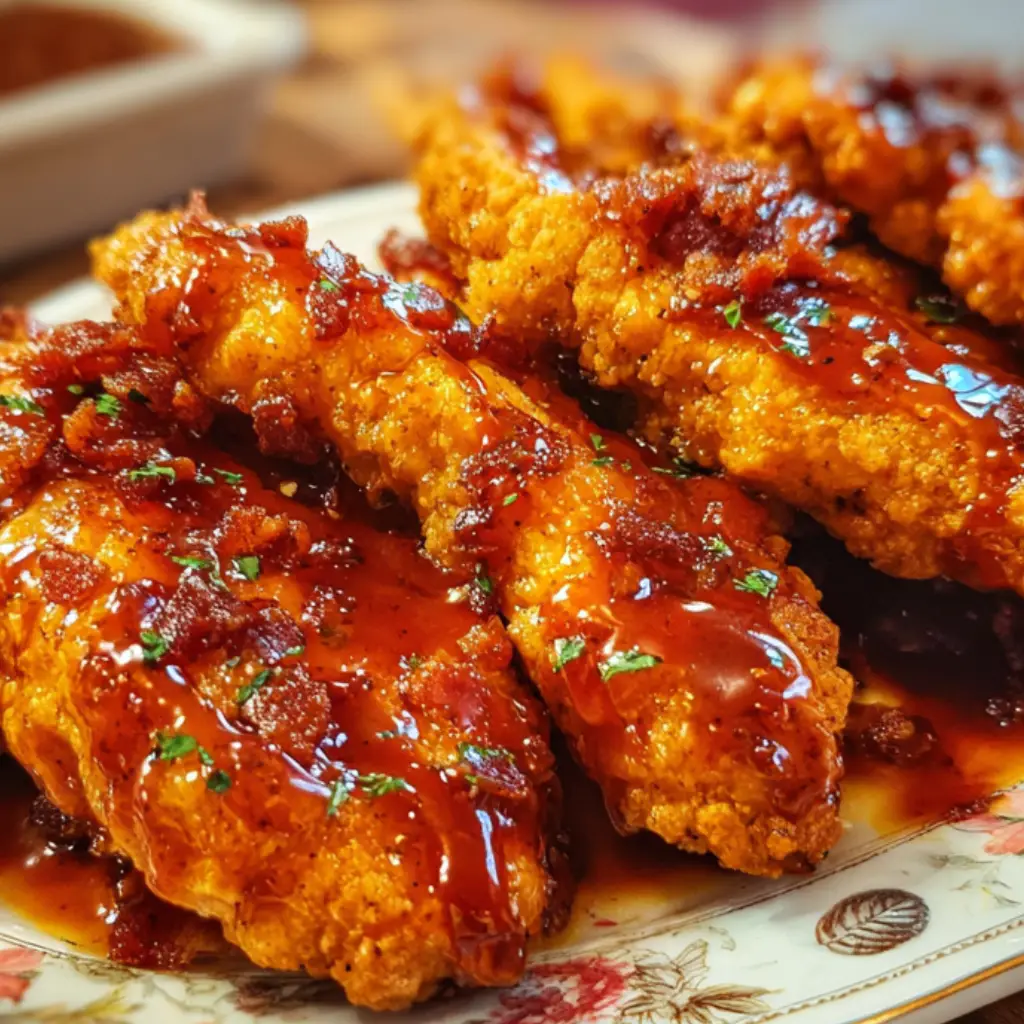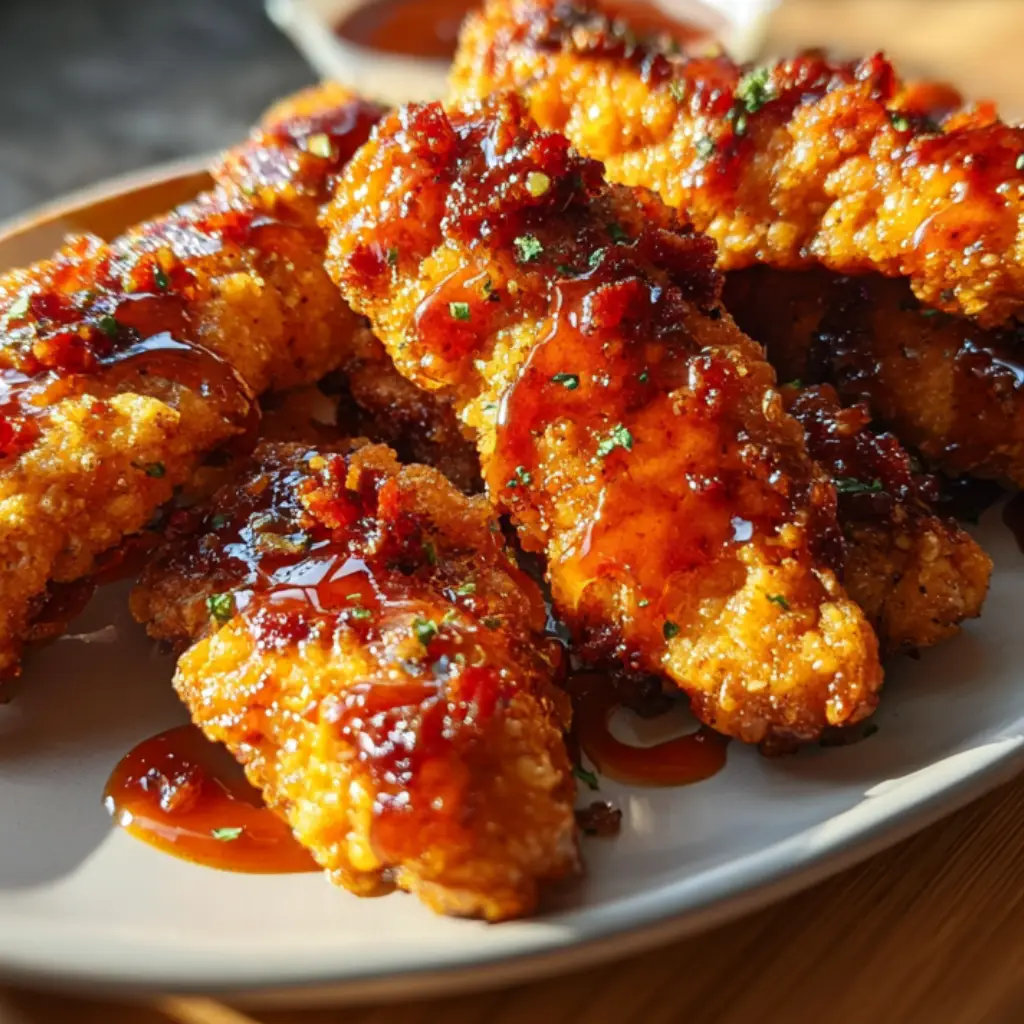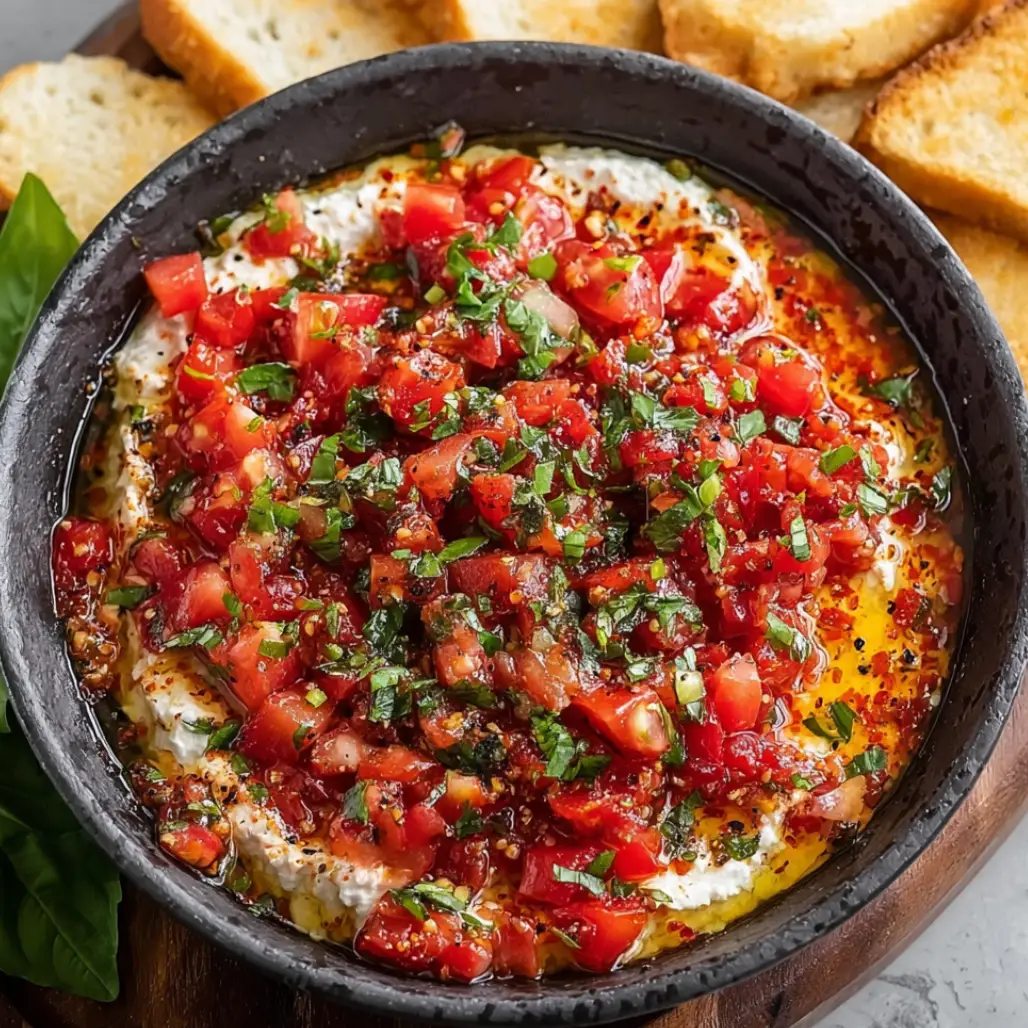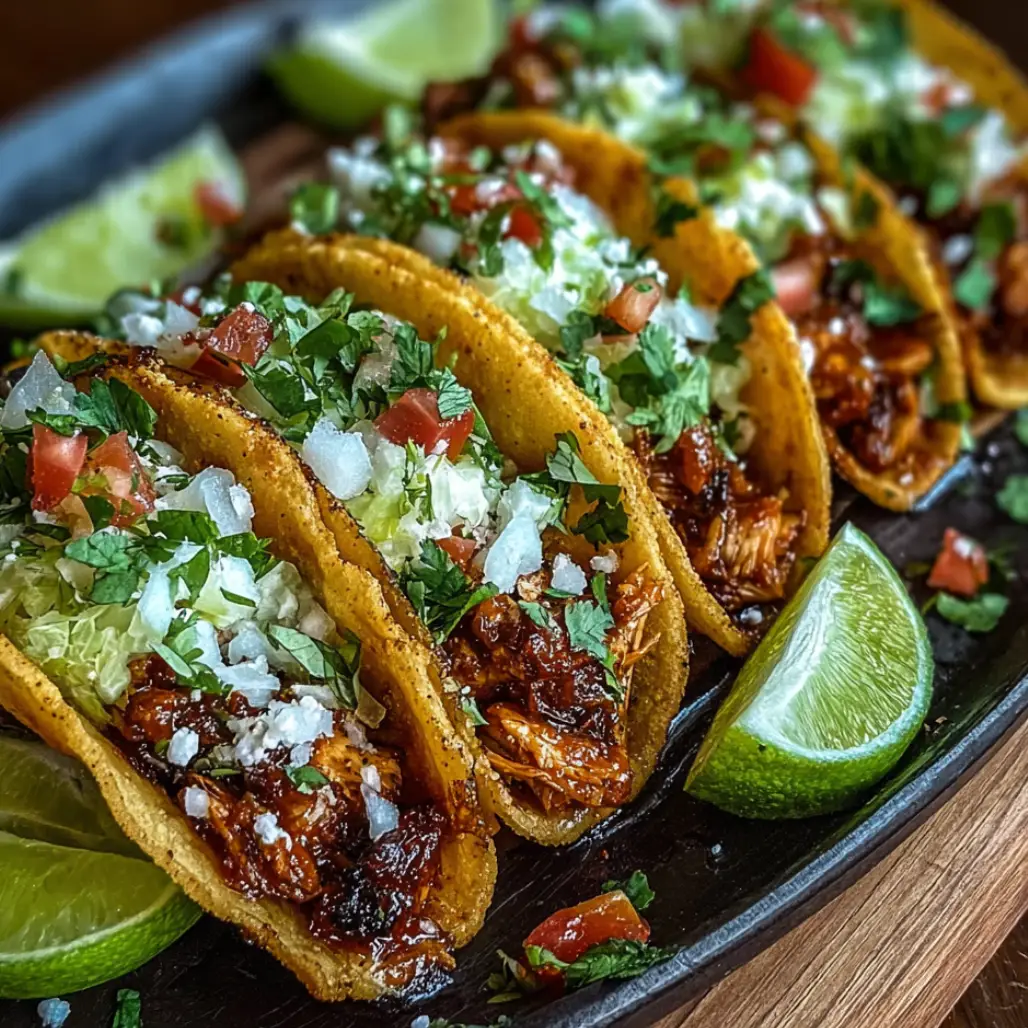| Prep Time: 15 minutes | Cook Time: 25 minutes | Total Time: 40 minutes | Serves: 6 |
|---|
When dinnertime calls for something extraordinary that bridges the gap between comfort food and gourmet dining, bacon brown sugar chicken tenders deliver the perfect harmony of sweet and savory flavors because they transform simple chicken strips into restaurant-quality indulgence through the magical combination of crispy bacon and caramelized brown sugar. These irresistible tenders showcase the art of flavor layering, where smoky bacon provides the perfect salty counterpoint to the rich sweetness of brown sugar while creating an addictive glaze that caramelizes beautifully during baking because the natural sugars develop complex depth and create an appealing golden finish that makes every bite memorable.
Why This Bacon Brown Sugar Chicken Tenders Recipe Works
The brilliance of these bacon brown sugar chicken tenders lies in their sophisticated simplicity because they require minimal ingredients while delivering maximum flavor impact through strategic layering of complementary tastes and textures. The bacon serves multiple crucial functions beyond mere flavor enhancement, acting as a natural basting agent that keeps the chicken incredibly moist while its rendered fat creates the ideal cooking environment for caramelizing the brown sugar coating.
This recipe succeeds where others fall short because it achieves the perfect balance between sweet and savory elements, avoiding the common pitfall of overwhelming sweetness that can characterize similar dishes. The brown sugar mixture penetrates the meat while the bacon crisps to perfection, creating textural contrast that elevates the entire eating experience because each element maintains its distinct character while contributing to a harmonious whole that satisfies multiple craving categories simultaneously.
Essential Ingredients for Perfect Results
2 pounds boneless skinless chicken tenders (or chicken breasts cut into strips)
12-14 strips thick-cut bacon (quality matters for optimal flavor and texture)
3/4 cup packed light brown sugar (provides the signature caramelized sweetness)
2 teaspoons smoked paprika (adds depth and smoky complexity)
1 teaspoon garlic powder (enhances savory undertones)
1 teaspoon onion powder (contributes aromatic base notes)
1/2 teaspoon black pepper (provides subtle heat and balance)
1/2 teaspoon kosher salt (enhances all flavors without overpowering)
1/4 teaspoon cayenne pepper (optional, for gentle heat that complements sweetness)
1 tablespoon chili powder (adds warmth and complexity to the sugar mixture)
2 tablespoons olive oil (for preparing the baking surface)
Wooden toothpicks (for securing bacon wrapping during cooking)
The Art of Creating Exceptional Bacon Brown Sugar Chicken Tenders
Creating exceptional bacon brown sugar chicken tenders requires understanding the delicate interplay between cooking temperatures and timing because the goal is achieving perfectly cooked chicken, crispy bacon, and properly caramelized sugar without burning or undercooking any component. The key lies in recognizing that different elements cook at varying rates, requiring strategic preparation and monitoring to ensure optimal results throughout the cooking process.
Success depends on proper bacon selection and wrapping technique because thick-cut bacon provides better coverage and more substantial texture while requiring adequate cooking time to achieve the desired crispiness. The brown sugar mixture must be applied generously enough to create effective caramelization while avoiding excessive amounts that could burn before the protein reaches safe internal temperatures, making ingredient balance crucial for achieving restaurant-quality results.
Step-by-Step Instructions for Perfect Results
Begin by preheating your oven to 375°F and lining a large rimmed baking sheet with parchment paper because proper preparation prevents sticking while creating easy cleanup after the bacon renders its fat during cooking. Position the oven rack in the center position to ensure even heat distribution throughout the cooking process.
Professional Tip: Use parchment paper rather than aluminum foil because it provides better non-stick properties and prevents the brown sugar from burning onto the pan surface.
Key Points: Proper oven preparation and positioning ensure even cooking while preventing common issues like uneven browning or burnt sugar residue.
Pat the chicken tenders completely dry with paper towels, then season lightly with salt and pepper because removing excess moisture helps the bacon adhere properly while preventing steam buildup that could interfere with browning. If using chicken breasts, slice them into tender-sized strips approximately 1 inch thick for consistent cooking times.
Professional Tip: Allow chicken to come to room temperature for 15 minutes before cooking because this promotes even cooking throughout the meat while reducing the risk of overcooked exteriors and undercooked centers.
Key Points: Proper moisture removal and temperature conditioning create optimal conditions for bacon adhesion and even cooking throughout the protein.
In a medium bowl, combine the brown sugar, smoked paprika, garlic powder, onion powder, black pepper, chili powder, and cayenne pepper, whisking thoroughly to ensure even distribution because uniform seasoning prevents hot spots while creating consistent flavor throughout each piece. The mixture should have no lumps and appear evenly colored.
Professional Tip: Sift the brown sugar if it contains lumps because smooth mixture distributes more evenly and creates better caramelization during the cooking process.
Key Points: Thorough spice integration ensures consistent flavor distribution while preventing uneven sweetness or spice concentration in the finished dish.
Wrap each chicken tender with one strip of bacon, starting at one end and spiraling around the meat while slightly overlapping each wrap because this technique ensures complete coverage and prevents the bacon from unraveling during cooking. Secure the bacon ends with toothpicks, tucking them underneath the tender to prevent exposure to direct heat.
Professional Tip: Stretch the bacon slightly while wrapping because this helps achieve tighter adherence and prevents gaps that could allow juices to escape during cooking.
Key Points: Proper wrapping technique ensures bacon stays in place while cooking evenly and maintaining moisture within the chicken throughout the baking process.
Generously coat each bacon-wrapped tender with the brown sugar spice mixture, pressing gently to ensure adherence because the coating needs to stick well enough to caramelize properly without falling off during cooking. Use all of the mixture, distributing it evenly among all pieces for consistent results.
Professional Tip: Apply the coating immediately after wrapping because the bacon’s natural moisture helps the spices adhere better than if you wait too long.
Key Points: Generous coating application ensures proper caramelization while pressing helps the mixture adhere effectively throughout the cooking process.
Arrange the coated tenders on the prepared baking sheet, spacing them at least 1 inch apart because adequate spacing allows proper air circulation while preventing the pieces from steaming together during cooking. The bacon seams should face downward to prevent unraveling.
Professional Tip: Avoid overcrowding the pan because proper spacing ensures even browning and prevents the tenders from cooking in their own steam.
Key Points: Strategic placement promotes optimal cooking conditions while preventing common issues like uneven browning or soggy bacon portions.
Bake for 20-25 minutes, checking at the 20-minute mark because cooking times vary based on tender thickness and bacon quality, and you want to ensure the internal temperature reaches 165°F while the bacon achieves desired crispiness. The brown sugar should be caramelized and golden brown without burning.
Professional Tip: Use a meat thermometer to check internal temperature because visual cues alone can be misleading with the dark coating covering the meat.
Key Points: Careful timing and temperature monitoring ensure food safety while achieving optimal texture and flavor development throughout the cooking process.
If additional bacon crisping is desired, switch the oven to broil setting and cook for an additional 2-3 minutes, watching carefully because the brown sugar coating can burn quickly under direct heat. Remove immediately when the bacon reaches your preferred level of crispiness.
Professional Tip: Keep the oven door slightly open while broiling because this allows you to monitor the browning process and prevents overheating that could burn the sugar coating.
Key Points: Optional broiling step enhances bacon texture while requiring careful attention to prevent burning the caramelized sugar coating.
Remove from oven and let rest for 5 minutes before serving because this allows the juices to redistribute while the coating sets properly, creating the optimal eating experience. Remove toothpicks carefully before serving to guests.
Professional Tip: Save any pan drippings because they make an excellent glaze when drizzled over the finished tenders or served as a dipping sauce.
Key Points: Proper resting time ensures optimal texture and flavor while allowing safe handling temperature for immediate service.
Professional Tips for Culinary Excellence
Bacon selection proves crucial for optimal results because thick-cut varieties provide better coverage and more substantial texture while rendering less fat that could create greasy conditions during cooking. Choose bacon with good meat-to-fat ratio because excessive fat can cause flare-ups or excessive rendering that interferes with proper caramelization of the brown sugar coating.
Temperature monitoring becomes essential when working with sugar-based coatings because brown sugar can transition rapidly from perfectly caramelized to burnt, creating bitter flavors that overwhelm the dish. Invest in a reliable instant-read thermometer because it ensures food safety while preventing overcooking that could dry out the delicate chicken meat.
Timing coordination requires attention because different oven models may cook at varying rates, making it important to check progress regularly during the final cooking stages. Start checking for doneness at the minimum recommended time because bacon brown sugar chicken tenders can quickly progress from perfect to overcooked without careful monitoring.
Creative Variations to Explore
Transform your bacon brown sugar chicken tenders into international flavor profiles by incorporating different spice blends such as Chinese five-spice, curry powder, or Mediterranean herbs because these additions create unique taste experiences while maintaining the essential sweet-savory balance. Consider adding maple syrup to the brown sugar mixture for deeper complexity and enhanced caramelization properties.
For those who enjoy heat, experiment with different pepper varieties such as chipotle powder, jalapeño seasoning, or hot honey drizzled over the finished tenders because spicy elements provide excellent contrast to the sweet coating while adding excitement for adventurous palates. Bourbon or whiskey can be added to the brown sugar mixture for sophisticated adult flavors.
Create seasonal variations by incorporating autumn spices like cinnamon and nutmeg, or summer herbs like fresh thyme and rosemary because these additions reflect seasonal ingredients while maintaining the recipe’s essential character. Fruit-based additions such as orange zest or apple cider reduction can provide fresh complexity that enhances the overall flavor profile.
Perfect Pairing Ideas for Complete Meals
Serve your bacon brown sugar chicken tenders with complementary side dishes that balance the rich, sweet flavors while providing textural contrast and nutritional completeness. Consider roasted vegetables, creamy coleslaw, or garlic mashed potatoes because these accompaniments enhance the meal without competing with the tenders’ distinctive flavors. Explore various savory sides that pair beautifully with sweet and savory protein dishes.
For lighter accompaniments, pair these indulgent tenders with fresh salads featuring crisp greens, seasonal vegetables, and tangy dressings because the acidity cuts through the richness while providing refreshing contrast that cleanses the palate between bites.
Create impressive appetizer presentations by cutting the tenders into bite-sized pieces and serving with various dipping sauces, making them perfect for parties and gatherings. Browse through creative snacks and appetizers for additional serving inspiration that showcases these versatile tenders.
Discover More Culinary Adventures
Enhance your meal presentations with thoughtfully selected dips and marinades that complement the sweet-savory profile while providing interactive dining experiences that engage guests and family members in customizing their plates according to personal preferences.
Complete your dining experience with carefully chosen beverages that balance the rich flavors while cleansing the palate and providing hydration that supports the enjoyment of these substantial, flavorful tenders.
Expand your breakfast repertoire by serving these tenders alongside morning favorites because their sweet profile makes them surprisingly compatible with breakfast foods, creating unique brunch presentations that impress guests with unexpected flavor combinations.
Storage Guidelines for Food Safety
Store leftover bacon brown sugar chicken tenders in airtight containers in the refrigerator for up to three days because proper storage maintains food safety while preserving flavor and texture throughout the recommended consumption period. Always refrigerate within two hours of cooking to prevent bacterial growth that could compromise food safety.
For reheating, use the oven at 350°F for 8-10 minutes rather than the microwave because this method helps restore the crispy bacon texture while warming the chicken evenly throughout. Avoid repeated reheating because this can dry out the meat and compromise the coating’s appealing texture.
These tenders can be prepared in advance up to the point of baking, then covered and refrigerated overnight before cooking because make-ahead preparation saves time while allowing flavors to meld and develop. Remove from refrigeration 30 minutes before baking to ensure even cooking throughout.
The Science Behind Perfect Caramelization
Brown sugar caramelization occurs when sucrose molecules break down under heat, creating complex flavors and appealing golden colors because the Maillard reaction produces hundreds of new flavor compounds that enhance the overall taste experience. Understanding this process helps explain why proper temperature control proves so crucial for achieving optimal results without burning.
Bacon fat renders during cooking, creating a natural basting environment that keeps chicken moist while providing the lipids necessary for proper heat transfer and flavor development because fat conducts heat more efficiently than air, ensuring even cooking throughout the protein. This rendered fat also contributes to the caramelization process by providing additional heat transfer medium.
The salt in bacon helps break down protein structures through osmosis, making the chicken more tender while enhancing flavor penetration because salt molecules draw out moisture initially before redistributing it back into the meat along with dissolved flavors from the coating mixture.
Troubleshooting Common Issues
If your bacon brown sugar chicken tenders turn out with burnt coating but undercooked chicken, the oven temperature was likely too high because sugar burns at lower temperatures than proteins cook, requiring careful heat management. Reduce temperature by 25°F and extend cooking time to achieve proper balance between coating caramelization and protein doneness.
Soggy bacon typically results from insufficient cooking time or overcrowded pans because steam buildup prevents proper crisping while inadequate heat circulation interferes with fat rendering. Ensure adequate spacing and consider the optional broiling step to achieve desired bacon texture.
Uneven browning usually indicates poor oven heat distribution or inadequate coating application because hot spots create irregular cooking patterns while thin coating areas fail to caramelize properly. Rotate the pan halfway through cooking and ensure generous, even coating application for consistent results.
Additional Inspirations for Home Cooking
Explore complementary side dishes that enhance bacon-wrapped protein presentations while providing nutritional balance and visual appeal that creates restaurant-quality dining experiences in home kitchens.
Discover creative dessert options that build on sweet and savory flavor themes, allowing you to create cohesive menus that showcase similar techniques while expanding your culinary repertoire with confidence.
Build themed dinner parties around bacon and brown sugar combinations, demonstrating how these flavors work across different protein types and cooking methods while impressing guests with sophisticated yet approachable cuisine that celebrates comfort food elevated to gourmet status.
Conclusion
These bacon brown sugar chicken tenders represent the perfect fusion of comfort food familiarity and gourmet sophistication because they transform simple ingredients into extraordinary dining experiences through strategic flavor layering and proper cooking techniques. The combination of crispy bacon, caramelized brown sugar, and tender chicken creates a memorable dish that satisfies both everyday family dinners and special occasion entertaining needs while building confidence in home cooking skills.
The versatility of this recipe opens endless possibilities for customization and creativity because the basic technique accommodates various spice profiles, dietary modifications, and presentation styles without compromising the essential character that makes these tenders so universally appealing. Whether served as appetizers for game day gatherings or featured as the centerpiece of elegant dinner parties, bacon brown sugar chicken tenders provide the foundation for countless memorable meals that bring people together around the table while celebrating the simple pleasure of expertly prepared comfort food that exceeds expectations.









